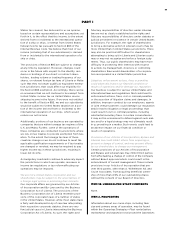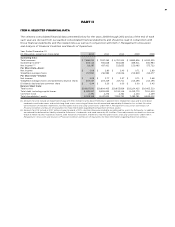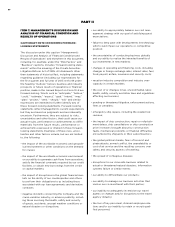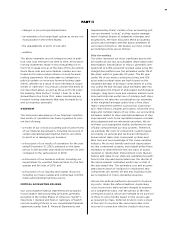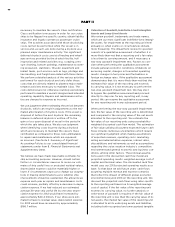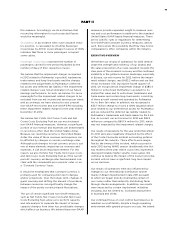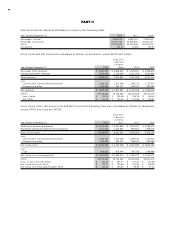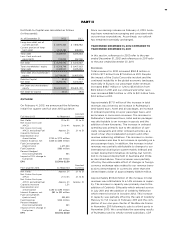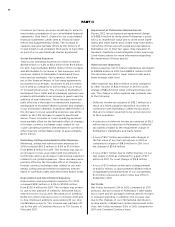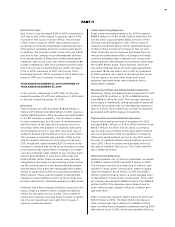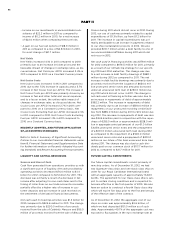Royal Caribbean Cruise Lines 2012 Annual Report Download - page 47
Download and view the complete annual report
Please find page 47 of the 2012 Royal Caribbean Cruise Lines annual report below. You can navigate through the pages in the report by either clicking on the pages listed below, or by using the keyword search tool below to find specific information within the annual report.
43
PART II
We enter into foreign currency forward contracts and
collars, interest rate, cross-currency and fuel swaps
and options with third-party institutions in over-the-
counter markets. We estimate the fair value of our
foreign currency forward contracts and interest rate
and cross-currency swaps using expected future
cash flows based on the instruments’ contract terms
and published forward curves for foreign currency
exchange and interest rates. We apply present value
techniques and LIBOR-based discount rates to con-
vert the expected future cash flows to the current fair
value of the instruments.
We estimate the fair value of our foreign currency
collars using standard option pricing models with
inputs based on the options’ contract terms, such as
exercise price and maturity, and readily available
public market data, such as foreign exchange curves,
foreign exchange volatility levels and discount rates.
We estimate the fair value of our fuel swaps using
expected future cash flows based on the swaps’ con-
tract terms and forward prices. We derive forward
prices from forward fuel curves based on pricing
inputs provided by third-party institutions that trans-
act in the fuel indices we hedge. We validate these
pricing inputs against actual market transactions and
published price quotes for similar assets. We apply
present value techniques and LIBOR-based discount
rates to convert the expected future cash flows to
the current fair value of the instruments. We also
corroborate our fair value estimates using valuations
provided by our counterparties.
We estimate the fair value for our fuel call options
based on the prevailing market price for the instru-
ments consisting of published price quotes for similar
assets based on recent transactions in an active market.
We adjust the valuation of our derivative financial
instruments to incorporate credit risk, when applicable.
We believe it is unlikely that materially different
estimates for the fair value of our foreign currency
forward contracts and interest rate, cross-currency
and fuel swaps and options would be derived from
other appropriate valuation models using similar
assumptions, inputs or conditions suggested by
actual historical experience.
Contingencies—Litigation
On an ongoing basis, we assess the potential liabilities
related to any lawsuits or claims brought against us.
While it is typically very difficult to determine the
timing and ultimate outcome of such actions, we use
our best judgment to determine if it is probable that
we will incur an expense related to the settlement or
final adjudication of such matters and whether a rea-
sonable estimation of such probable loss, if any, can
be made. In assessing probable losses, we take into
consideration estimates of the amount of insurance
recoveries, if any. We accrue a liability when we
believe a loss is probable and the amount of loss can
be reasonably estimated. Due to the inherent uncer-
tainties related to the eventual outcome of litigation
and potential insurance recoveries, it is possible that
certain matters may be resolved for amounts materi-
ally different from any provisions or disclosures that
we have previously made.
SEASONALITY
Our revenues are seasonal based on demand for
cruises. Demand is strongest for cruises during the
Northern Hemisphere’s summer months and holidays.
In order to mitigate the impact of the winter weather
in the Northern Hemisphere and to capitalize on the
summer season in the Southern Hemisphere, our brands
have increased deployment to South America and
Australia during the Northern Hemisphere winter
months.
FINANCIAL PRESENTATION
DESCRIPTION OF CERTAIN LINE ITEMS
Revenues
Our revenues are comprised of the following:
• Passenger ticket revenues, which consist of revenue
recognized from the sale of passenger tickets and the
sale of air transportation to and from our ships; and
• Onboard and other revenues, which consist primarily
of revenues from the sale of goods and/or services
onboard our ships not included in passenger ticket
prices, cancellation fees, sales of vacation protection
insurance, pre- and post-cruise tours, Pullmantur’s
land-based tours and hotel and air packages includ-
ing Pullmantur Air’s charter business to third parties.
Onboard and other revenues also include revenues we
receive from independent third-party concessionaires
that pay us a percentage of their revenues in exchange
for the right to provide selected goods and/or services
onboard our ships.
Cruise Operating Expenses
Our cruise operating expenses are comprised of the
following:
• Commissions, transportation and other expenses,
which consist of those costs directly associated with
passenger ticket revenues, including travel agent
commissions, air and other transportation expenses,
port costs that vary with passenger head counts
and related credit card fees;


